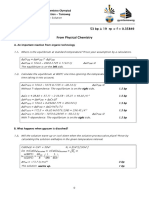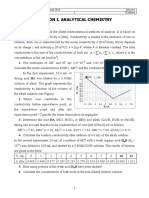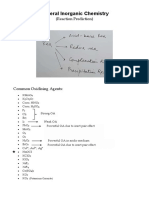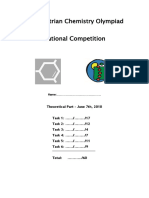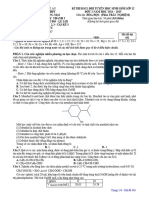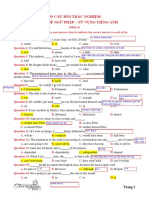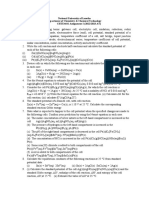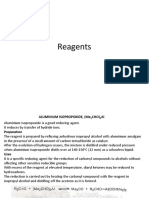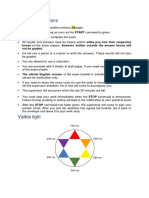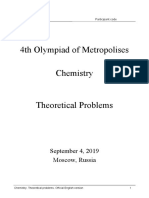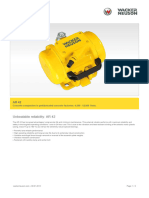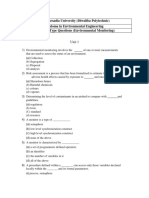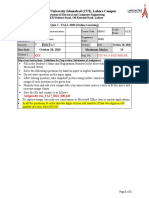61 - 06Mar2024 - IOM Lần 4 Đáp án tiếng Anh
61 - 06Mar2024 - IOM Lần 4 Đáp án tiếng Anh
Uploaded by
Keo DzCopyright:
Available Formats
61 - 06Mar2024 - IOM Lần 4 Đáp án tiếng Anh
61 - 06Mar2024 - IOM Lần 4 Đáp án tiếng Anh
Uploaded by
Keo DzOriginal Description:
Original Title
Copyright
Available Formats
Share this document
Did you find this document useful?
Is this content inappropriate?
Copyright:
Available Formats
61 - 06Mar2024 - IOM Lần 4 Đáp án tiếng Anh
61 - 06Mar2024 - IOM Lần 4 Đáp án tiếng Anh
Uploaded by
Keo DzCopyright:
Available Formats
Country Participant code
4th Olympiad of Metropolises
Chemistry
Theoretical Problems
Answers, solutions, and grading scheme
September 4, 2019
Moscow, Russia
Chemistry. Theoretical problems. Official English version 1
Country Participant code
Instructions
Begin only when the START command is given. You have 4,5 hours to work on the
problems.
Use only the pen and calculator provided.
All results must be written in the appropriate boxes within the text. Anything written
elsewhere will not be graded. Use the reverse of the problem pages if you need scratch paper.
Write relevant calculations in the appropriate boxes when necessary. If you provide only
correct end results for complicated questions, you will receive no score.
Raise your hand if you have any questions concerning the text of the problems.
Raise your hand if you need a restroom break.
The official English version of this examination is available on request only for clarification.
Recommendations
* Read the text carefully. Try to understand properly: a) what is given to you, b) what is
required from you.
* All the problems contain questions of various complexity including very simple ones. Try to
answer as many questions as you can. Try to leave as few empty spaces in the answer sheets as
you can.
* In the calculations, use the atomic masses from the Periodic table given to you.
Good luck!
Chemistry. Theoretical problems. Official English version 2
Country Participant code
Constants
Avogadro constant NA = 6.022·1023 mol–1
Gas constant R = 8.314 J K–1 mol–1
Elementary charge e = 1.602 10–19 C
Speed of light c = 2.998 108 m s–1
Planck constant h = 6.626 10–34 J s
Zero of the Celsius
273.15 K
scale:
Consider all gases ideal.
Periodic table with relative atomic masses
1 18
1 2
H He
1.008 2 13 14 15 16 17 4.003
3 4 5 6 7 8 9 10
Li Be B C N O F Ne
6.94 9.01 10.81 12.01 14.01 16.00 19.00 20.18
11 12 13 14 15 16 17 18
Na Mg Al Si P S Cl Ar
22.99 24.30 3 4 5 6 7 8 9 10 11 12 26.98 28.09 30.97 32.06 35.45 39.95
19 20 21 22 23 24 25 26 27 28 29 30 31 32 33 34 35 36
K Ca Sc Ti V Cr Mn Fe Co Ni Cu Zn Ga Ge As Se Br Kr
39.10 40.08 44.96 47.87 50.94 52.00 54.94 55.85 58.93 58.69 63.55 65.38 69.72 72.63 74.92 78.97 79.90 83.80
37 38 39 40 41 42 43 44 45 46 47 48 49 50 51 52 53 54
Rb Sr Y Zr Nb Mo Tc Ru Rh Pd Ag Cd In Sn Sb Te I Xe
85.47 87.62 88.91 91.22 92.91 95.95 - 101.1 102.9 106.4 107.9 112.4 114.8 118.7 121.8 127.6 126.9 131.3
55 56 72 73 74 75 76 77 78 79 80 81 82 83 84 85 86
Cs Ba 57-71 Hf Ta W Re Os Ir Pt Au Hg Tl Pb Bi Po At Rn
132.9 137.3 178.5 180.9 183.8 186.2 190.2 192.2 195.1 197.0 200.6 204.4 207.2 209.0 - - -
87 88 104 105 106 107 108 109 110 111 112 113 114 115 116 117 118
Fr Ra 89-103 Rf Db Sg Bh Hs Mt Ds Rg Cn Nh Fl Mc Lv Ts Og
- - - - - - - - - - - - - - - - -
57 58 59 60 61 62 63 64 65 66 67 68 69 70 71
La Ce Pr Nd Pm Sm Eu Gd Tb Dy Ho Er Tm Yb Lu
138.9 140.1 140.9 144.2 - 150.4 152.0 157.3 158.9 162.5 164.9 167.3 168.9 173.0 175.0
89 90 91 92 93 94 95 96 97 98 99 100 101 102 103
Ac Th Pa U Np Pu Am Cm Bk Cf Es Fm Md No Lr
- 232.0 231.0 238.0 - - - - - - - - - - -
Chemistry. Theoretical problems. Official English version 3
Country Participant code
Problem 1. Kremlin stars (10 marks)
Question 1 2 3 4 5 6 7 8 Sum
Points 6 2 2 10 2 4 2 2 30
Result
The Kremlin towers crowned with red stars are among the best known symbols of Moscow. For the
first time, ruby glass stars appeared on the towers in 1937. According to chemical analysis, ruby glass
contains sodium, potassium, silicon, oxygen, sulfur, selenium, cadmium and the unknown element X.
1. The color of the glass is caused by nanoparticles formed during heating of a sample of the
finished glass. Excluding element X from consideration, propose three possible formulas for
nanoparticles containing two or three elements in this glass.
1) CdxSx or (CdS)x or Cd100S100 2 pts
2) CdxSex or (CdSe)x or Cd100Se100 2 pts
3) CdxSySex–y or Cdx+ySxSey or Cd100S50Se50 2 pts
Element X is introduced into the glass in the form of substance X1, which is a white powder, insoluble
in water. Hydrochloric acid converts it to X2. Addition of ammonium carbonate solution to the
solution of X2 leads to the formation of a white crystalline precipitate X3. Heat treatment of X3 (10.00
g) gives X1 (7.41 g). Other products of this reaction are carbon dioxide and 0.99 g of colorless liquid
X4 widely used as a solvent.
2. What class of compounds does X1 belong to?
Class of X1 – oxide 2 pts
3. Write down the formula of substance X4.
X4 – H2O 2 pts
4. Determine the formulas of X1 and X3, name element X. Show your calculations.
Chemistry. Theoretical problems. Official English version 4
Country Participant code
Calculations
m(CO2) = 10 – 7.4 – 0.99 = 1.61 g, n(CO2) = 1.61 / 44 = 0.0366 mol 2 pts
n(H2O) = 0.99 / 18 = 0.055 mol, n(CO2) : n(H2O) = 1 : 1.5 = 2 : 3 2 pts
M(X3) = 10 2 / 0.0366 = 546.4 g/mol,
546.4 – 2 44 – 3 18 = 404.4 = 5 81 (M(ZnO) = 81 g/mol)
X1 – ZnO 2 pts
X3 – 5ZnO·2CO2·3H2O or Zn5(CO3)2(OH)6 3 pts
X – Zn 1 pt
5. Give the formula of substance Х2.
X2 – ZnCl2 2 pts
6. Write down the reactions of X1 with HCl and NaOH.
ZnO + 2HCl = ZnCl2 + H2O 2 pts
ZnO + 2NaOH + H2O = Na2[Zn(OH)4]
or 2 pts
ZnO + 2NaOH = Na2ZnO2 + H2O
7. What phenomenon is responsible for the color of the Kremlin stars? Choose one answer.
1) electronic transitions in a semiconductor nanoparticle
2) surface plasmon resonance
3) d-d transitions in a metal ion
4) light absorption by defects in glass
Number of the correct answer: 1
Chemistry. Theoretical problems. Official English version 5
Country Participant code
8. The figure below presents the absorption spectra of three glasses. Which of them corresponds
to the red ruby glass Kremlin stars?
Number of the correct spectrum: 1
Chemistry. Theoretical problems. Official English version 6
Country Participant code
Problem 2. Who planted scorpion, or Chemist’s nightmares after reading detective stories
(10 marks)
Question 1 2 3 4 Sum
Points 1 4 1 5 11
Result
For many years, qualitative reactions were among the most important methods for determining the
structure of organic compounds. Ninhydrin test for amines is still a widely used qualitative reaction.
Ninhydrin (A) – monohydrate of indane-1,2,3-trione – as well as its reaction with amino acids were
discovered by Siegfried Ruhemann in 1910. In 1954 it was shown that ninhydrin is an excellent
reagent for visualization of latent fingerprints. It is still in use for this purpose.
1. Write down the structural formula of ninhydrin taking into account that in this case “hydrate”
means the structure where water molecule is added to one of the carbonyl groups.
Ninhydrin, А
1 pt
Ninhydrin test can be described by the following scheme:
2. Decipher this scheme: write down the structural formulas of compounds B–E, taking into
account that С and D are position isomers; D can exist in either trans- or cis-form but С has no
geometrical isomers.
B C
1 pt 1 pt
Chemistry. Theoretical problems. Official English version 7
Country Participant code
D E
1 pt 1 pt
Typically, primary amines undergo the above transformations affording bright-blue or purple
products. Secondary amines can participate only in some of these transformations producing yellow
or orange products.
3. Using the general formula of secondary amines RCH2NHR', suggest the possible structural
formula(s) for such products.
Possible structural formula(s)
1 pt for any of these structures
In 2018, the compound F was isolated as a white powder from the venom of Mexican scorpion
Megacormus gertschi. Ninhydrin test produced no intense coloring; the structure of F was
determined by modern physico-chemical methods. Thus, high-resolution mass spectrometry analysis
gave the exact molecular weight for monoprotonated F – 318.1450. Experiments on the H/D
exchange showed that F contains three protons that can be easily substituted by deuterium (–OH or
–NH group). NMR method demonstrated the presence of one –OH group, two –OMe groups and one
–CH2CH2– fragment. These and some other data enabled to determine the structure of F which was
then proved by counter synthesis according to the scheme below.
Here, Me is methyl, Et is ethyl, LDA is lithium diisopropylamide (strong base), DCC/HOBt/DIPEA
is the system used for the coupling of amines and carboxylic acids (DCC is dicyclohexylcarbodimide,
HOBt is 1-hydroxybenzotriazole, DIPEA is diisopropylethylamine).
Chemistry. Theoretical problems. Official English version 8
Country Participant code
4. Decipher the scheme of the F synthesis; write down the structures of compounds F–J.
G H I
1 pt 1 pt
1 pt
J F
1 pt 1 pt
Author’s comments
1. The formula of indane is given in the problem condition. It is clear that three carbonyl groups
should be present only in the five-membered ring. Therefore, indane-1,2,3-trione has two types of
carbonyl groups: two “terminal” groups (at atoms C(1) and C(3)) and the central one (at C(2) atom).
The latter atom is more reactive because this group has two other carbonyl functions in the direct
vicinity; therefore, C(2) atom should have the most positive charge while the positive charges at C(1)
and C(3) atoms are partially quenched due to mesomeric effect of the benzene ring. In other way, C(2)
atom should react with nucleophiles better than two other carbonyl carbons. Therefore, we conclude
that the central group is hydrated. This supposition is supported by the fact that ninhydrin is
monohydrate as well as by the structure of the colored product. (The correct structure is estimated by
1 point, the structure with hydrated terminal carbonyl group by 0.5 points; other structures give no
points).
2. The first step in the reaction of ninhydrin with amino acid is accompanied by elimination of two
water molecules. There are two ways to achieve this result. The first is the reaction of two carbonyl
groups with two molecules of amino acid yielding bis-imine. The second is the elimination of
“hydrate” water producing indane-1,2,3-trione followed by its reaction with one amino acid molecule
affording the corresponding imine. Accounting for the formula of the final product as well as the fact
that one molecule of CO2 and one molecule of RCHO were eliminated during the total process, the
second possibility is correct. As discussed above, the central carbonyl group is more reactive than the
terminal carbonyls. The structure of the final product supports this conclusion. According to the
scheme, the imine formed undergoes decarboxylation leading to C for which there is no
cis-/trans-isomerism. Hence, two substituents at the carbon atom are identical. Nevertheless, С is in
Chemistry. Theoretical problems. Official English version 9
Country Participant code
equilibrium with its isomer D which can exist as either trans- or cis-isomer and undergoes hydrolysis
producing aldehyde RCHO. We can conclude that D is a product of a double bond shift in C. As a
result of its hydrolysis, 2-aminoindan-1,3-dione is formed (together with aldehyde RCHO); its
reaction with ninhydrin proceeds analogously to the reaction of ninhydrin with amino acid leading to
the product shown in the scheme. (4 structural formulas, 1 point for each; 4 points in total).
3. With the secondary amines, the reaction proceeds with the formation of an unstable iminium cation,
deprotonation of which yields a zwitter-ion. This ion can either dimerize or undergo proton shift
producing stable enaminodione (it is given here in a general form). Any structure given below will be
accepted as a correct answer (1 point). Other structures will be estimated depending on the possibility
of their formation and stability.
4. Deprotonation of methyl 2-methoxyacetic acid leads to the anion which reacts with vanillin
(4-hydroxy-3-methoxybenzaldehyde) via the carbonyl group attack affording the corresponding
alcoholate G. Its treatment with benzenesulfonyl chloride furnishes sulfonate H that undergoes
benzenesulfonate elimination under the treatment with triethylamine giving rise to methyl
4-hydroxy- ,3-dimethoxycinnamate I. In the text of the problem it is said that the last step is the
coupling of carboxylic acid with amine. Therefore, the last but one step (I to J transformation) is the
hydrolysis of ester. Compound F has one –OH group, two –OMe groups, –CH2CH2– fragment and
molecular weight 317 that corresponds to the data in the text of the problem.
5 structural formulas, 1 point for each. 5 points in total.
Chemistry. Theoretical problems. Official English version 10
Country Participant code
Problem 3. Personal electric transport for a big city (10 marks)
Question 1 2 3 4 5 6 Sum
Points 4 3 3 5 2 8 25
Result
In recent years, personal electric vehicles – bikes, bicycles, monowheels, scooters, and even cars have
become very popular in large cities, including Moscow. All of them use rechargeable batteries, which
convert chemical energy of redox reactions into electrical energy.
Lithium-ion batteries, where Li+ ions are transferred from the negative electrode to the positive one
through the electrolyte are most popular as compared to similar sodium-, magnesium-, and
aluminum-ion batteries. Specific capacity defined as the ratio of the transferred charge Q to the mass
m of the charge carriers and measured in milliampere-hours per gram (1 mAh/g = 3.6 C/g) is one of
the important characteristics of ion batteries.
1. Without calculations, arrange the above mentioned ionic batteries in the descending order of
their specific capacities. Calculate the specific capacity Q/m of the first battery in this
sequence.
Sequence: Li+ > Al3+ > Mg2+ > Na+
Note: compare the ratio of the molar mass of the ions to their charge. The smaller is this ratio, the
larger the specific capacity.
2 pts (1 pt for Li+ at the first place, 1 pt for the correct order of remaining ions)
Calculation:
Li+: Q / m = (1.602 10–19 C 6.02 1023 mol–1) / 6.94 g/mol = 13900 C g–1 = 3860 mA h g–1.
Q / m = 3860 mA h g–1 2 pts
Almost all lithium batteries use a graphite matrix intercalated with lithium as the negative electrode,
lithium atoms being stored between the graphene layers. The figure below shows a fragment of the
crystal structure of a stoichiometric compound of lithium and carbon. The light lines limit the unit cell
with the volume of 59.5 A3 (1 A = 10–10 m). Lithium atoms are located on vertical edges, whereas
carbon atoms on edges and faces in horizontal planes.
Chemistry. Theoretical problems. Official English version 11
Country Participant code
2. Determine the formula of this compound. Calculate the density of lithium in it (in g cm–3).
Calculation
In the unit cell, there are 4 C atoms on the faces and 16 C atoms on the edges in horizontal planes.
There are 4 Li atoms on vertical edges. The total number of atoms per unit cell:
N(C) = 4 (1/2) + 16 (1/4) = 6. 1 pt
N(Li) = 4 (1/4) = 1 1 pt
Formula – LiC6. (without calculations – 0 pts)
The density of lithium: = m(Li) / V = (6.94/(6.02 1023) g) / (59.5 10–24 cm3) = 0.194 g cm–3.
This is only 2.75 times less than the density of pure lithium metal.
1 pt
Formula: LiC6
Density of lithium: 0.194 g cm–3
3. Mixed lithium-cobalt oxide is a common material for the positive electrode. Using the
formulas of the electrodes CLix and Li1–xCoO2, write down the equations of the cathode and
anode half-reactions taking place during the battery discharge, and the overall reaction
equation.
Note: reduction occurs on cathode.
Cathode: Li1–xCoO2 + xLi+ + xe LiCoO2 1 pt
Anode: CLix – xe C + xLi+ 1 pt
Overall reaction: Li1–xCoO2 + CLix LiCoO2 + C 1 pt
Chemistry. Theoretical problems. Official English version 12
Country Participant code
A solution of a lithium salt in an organic solvent (like propylene carbonate) is a typical electrolyte in
lithium-ion batteries:
4. Characterize the solvent by ticking appropriate boxes. Suggest the reaction for its direct
synthesis from carbon dioxide.
protic aprotic polar nonpolar chiral
3 pts (1 pt for each correct property, minus 1 pt for each wrong choice, minimum – 0 pts)
Reaction equation: 2 pts
(Reactions of CO2 with propene or propane diol – 0 pts)
5. In E-bikes, a modified positive electrode LiNixMnyCo1–x–yO2 is used in the batteries.
Determine x and y (with two decimal places) given the mass content of the metals in the
electrode: Li – 7.19%, Ni – 20.08%, Mn – 18.79%.
Calculation:
M = 6.94 / 0.0719 = 96.52 g/mol
x = 96.52 0.2008 / 58.69 = 0.33
y = 96.52 0.1879 / 54.94 = 0.33
x = 0.33 y = 0.33
2 pts (1 pt for each value)
Electric vehicles do not pollute the city air directly. However, electric energy is not absolutely
“green”, because carbon dioxide is released into the atmosphere during its production by fuel
combustion. Compare the environmental friendliness of three vehicles: a E-bike, an electric car, and a
conventional car with the following characteristics:
Chemistry. Theoretical problems. Official English version 13
Country Participant code
Power capacity Distance on a Fuel Average price in
Vehicle of the battery, single battery consumption, Moscow, million
kWh charge, km L / 100 km roubles
E-bike 0.47 45 – 0.035
Electric car 50 400 – 4.5
Conventional car – – 10 1
6. For each of the vehicles, calculate the mass of CO2, released into the air (either by the vehicle
itself or during electric energy production) per 1 km distance.
Additional information:
Assume that the gasoline formula is C8H18.
Take the gasoline density as 750 g/L.
Electric energy is produced by methane combustion; take the efficiency of heat
transformation into electric energy as 30%.
1 kWh = 3600 kJ.
Substance CH4(g) CO2(g) H2O(g)
–1 –75 –394 –242
fH 298, kJ mol
Calculation:
CH4 + 2O2 = CO2 + 2H2O(g)
H = –394 + 2 (–242) – (–75) = –803 kJ/mol of CO2, 1 pt
Eel = 803 0.3 = 240.9 kJ/mol of CO2. 1 pt
E-bike.
Energy consumption: 0.47 (1/45) 3600 = 37.6 kJ, 1 pt
n(CO2) = 37.60/240.9 = 0.156 mol, 0.5 pts
m(CO2) = 0.156 44 = 6.9 g. 0.5 pts
Electric car.
Energy consumption: 50 (1/400) 3600 = 450 kJ, 1 pt
n(CO2) = 450/240.9 = 1.87 mol, 0.5 pts
m(CO2) = 1.87 44 = 82 g. 0.5 pts
Conventional car.
n(C8H18) = m / M = 10 (1/100) 750 / 114 = 0.66 mol 1 pt
C8H18 8CO2 0.5 pts
n(CO2) = 8 0.66 = 5.28 mol, m(CO2) = 5.28 44 = 232 g. 0.5 pts
m(CO2):
E-bike Electric car Conventional car
6.9 g 82 g 232 g
Total – 8 pts
You can decide yourself which vehicle is more convenient for you personally and which is most
eco-friendly.
Chemistry. Theoretical problems. Official English version 14
Country Participant code
Problem 4. Deicing reagents (10 marks)
Question 1 2 3 Sum
Points 4 4 8 16
Result
Removing ice from roads and sidewalks or making them less slippery is vital to keep cities safe in
winter. Depending on temperature and the amount of ice, several strategies are used to tackle this
problem. These include mechanical removal, dispersion of traction providers (e.g. granite crumbs or
sand), and use of anti-ice reagents. In this problem we will focus on the latter option and analyze it
using chemical thermodynamics.
Deicing reagents do not really react with ice. Instead, they depress its melting point. For diluted water
solutions, the difference between their freezing temperature and that of pure water can be estimated
using the following equation:
RT02
Tm.p. o
x
fus H
where ΔfusHo = 337 J/g is the enthalpy of fusion of water, T0 is its normal melting point (in K), R is the
universal gas constant, and x is the total molar fraction of all components of the solution except water
itself (note that possible dissociation should be taken into account in the calculation of x).
1. Sodium chloride, NaCl is one of the widely used deicing reagents. Calculate the mass of this
salt required to melt 7 mm thick ice on 1 m2 of a sidewalk at –3oC. The density of ice is 0.91
g/cm3.
Calculations
m(water) = 0.7 1002 0.91 = 6370 g = 6.37 kg
n(water) = 6370/18 = 354 mol 1 pt
x = 3 (337 18)/8.314/2732 = 0.0294 1.5 pts
n(ions) ≈ (1000/18) x = 1.63 mol/kg of water
n(NaCl) = n(ions)/2 = 0.815 mol/kg of water
m(NaCl) = 0.815 58.5 6.37 = 304 g 1.5 pts
4 points total
m(NaCl) = 304 g
The above equation is valid only for the diluted solutions. For larger salt : water ratios, phase diagram
should be used. For two most common reagents, NaCl and CaCl2, the water-salt phase diagrams for
Chemistry. Theoretical problems. Official English version 15
Country Participant code
subzero temperatures are presented below. These phase diagrams are qualitatively the same, the
phases are shown in the inset.
Temperature (oC)
Solution
Solution
Solution + solid
+ ice salt
Ice + solid salt
Mass fraction of the salt in the system, %
2. At what minimum temperatures NaCl and CaCl2 can be used for ice melting? How much salt
(in grams) is required to melt 1 kg of ice at this temperature in each case?
NaCl: CaCl2:
Tmin = –21oC (1 pt, ±1oC accepted) Tmin = –51oC (1 pt, ±1oC accepted)
299 g of salt / 1 kg of ice 420 g of salt / 1 kg of ice
(1 pt, ±30 g accepted) (1 pt, ±30 g accepted)
Total 4 pts
Chemistry. Theoretical problems. Official English version 16
Country Participant code
In real life, the thickness of ice film on the street varies and it is impossible to measure it directly
during dispersing deicing reagent. This reduces the efficiency of deicing procedure.
3. Assume that the thickness ice on the pavement ranges from 2 to 7 mm and that CaCl 2 is
distributed uniformly over it. Determine the lowest temperature at which it is possible to melt
the ice with any thickness in this range so that no ice or solid salt are left. How much CaCl2 (in
g/m2) is required for that?
Hint: convert the salt mass fractions on the diagram above into water/salt ratios. Temperature can be
determined graphically – you can place marks on the phase diagram.
Determination of temperature
7 mm / 2 mm = 3.5 (1 pt)
[m(H2O)/m(CaCl2)]right = 1.9 => [m(H2O)/m(CaCl2)]left = 9, ratio = 4.7
[m(H2O)/m(CaCl2)]right = 2.1 => [m(H2O)/m(CaCl2)]left = 3.8, ratio = 1.8
[m(H2O)/m(CaCl2)]right = 2.0 => [m(H2O)/m(CaCl2)]left = 5.4, ratio = 2.7
[m(H2O)/m(CaCl2)]right = 1.95 => [m(H2O)/m(CaCl2)]left = 7, ratio = 3.6 – almost correct
T = –9.5 oC (–6 oC to –15oC is accepted if the answer is based on correct reasoning) (4 pts)
5 pts total
Calculation of CaCl2 consumption:
At 2 mm thickness, m(H2O)/m(CaCl2) = 1.95 as determined earlier
m(ice) = 0.2 1002 0.91 = 1820 g (1 pt)
m(CaCl2) = 1820/1.95 = 933 g (2 pts)
Mass of CaCl2 required = 933 g/m2
3 pts total
Chemistry. Theoretical problems. Official English version 17
Country Participant code
Problem 5. Photosynthesis under low-light conditions (10 marks)
Question 1 2 3 4 5 6 Sum
Points 4 7 7 3 1 3 25
Result
Photosynthetic organisms are well known for their unbelievable ability to adapt to adverse conditions.
For example, cyanobacteria living in deep sea do not have enough light because most photons are
absorbed by other photosynthetic creatures living closer to the water surface. In such conditions, they
attain an ability to utilize far-red light of low energy. This light is absorbed by chlorophyll f
(maximum of light absorption at 707 nm). It differs from the common chlorophyll a (maximum of
light absorption at 665 nm) by only one substituent. Energy absorbed by chlorophylls f is transferred
to chlorophylls a and further to reaction centers where it is converted to chemical energy. The scheme
for excitation energy transfer between the chlorophylls is shown below.
1. Determine the enthalpy of energy transfer from chlorophyll f to chlorophyll a. Is the process
endo- or exothermic?
Calculation
Since volume change in this process is negligible, the enthalpy change is equal to the internal energy
change and, hence, to the difference between excitation energies of the chlorophylls: (1 pt)
ΔrH = NAhc(1/λa – 1/λf) = 6.022·1023·6.626·10–34·2.998·108·(1/(665·10–9) – 1/(707·10–9)) =
= 10.7 kJ/mol
ΔrH = 10.7 kJ/mol (2 pts)
Endo □ Exo □ (1 pt)
Total 4 pts
Chemistry. Theoretical problems. Official English version 18
Country Participant code
To determine the ratio of two types of chlorophyll in photosystem II they were extracted by methanol.
Absorbance (A) was determined at two different wavelengths in a cuvette with the unknown length:
A(665 nm) = 0.798 and A(707 nm) = 0.080. The absorption coefficients ε of both chlorophylls are
given in the table below.
ε(665 nm), ε(707 nm),
L mol–1 cm–1 L mol–1 cm–1
Chlorophyll a 70000 0
Chlorophyll f 15900 71100
2. Calculate the ratio of chlorophyll a to chlorophyll f in the photosystem II.
Calculation
A665 = εa,665cal + εf,665cfl (2 pts, 0 pts if εf,665cfl is missing)
A707 = εf,707cfl => (1 pt)
A665/l= εa,665ca + εf,665cf, 1/l =εf,707cf/A707 =>
A665/A707·εf,707cf = εa,665ca + εf,665cf => A665/A707= εa,665/εf,707·ca/cf + εf,665/εf,707 (2 pts)
Solution of the last equation gives ca/cf = 9.9.
a/f = 9.9 (2 pts)
Total 7 pts
Consider the excitation energy transfer between chlorophylls a and f as a reverse chemical reaction:
k1
F* + A F + A* (1)
k1
where F and A are the chlorophylls f and a, respectively, asterisk denotes the excited electronic state.
For the efficient energy transfer, the rate constant k1 of the direct process must be as close as possible
to the rate constant k–1 of the reverse transfer.
The ratio k1/k–1 is equal to the thermodynamic equilibrium constant K and, hence, it depends on the
standard reaction Gibbs energy ΔrGo. There are two general ways to reduce the Gibbs energy of the
process in photosystem II compared to that in isolated chlorophylls (where ΔrG ΔrH from p.1):
1) to increase the process entropy ΔrS (hypothesis 1), 2) to decrease the reaction enthalpy ΔrH
(hypothesis 2).
Entropy increase is achieved by energy transfer from one chlorophyll f to a larger pool of chlorophylls
a. Assume that all chlorophylls a have the same energy and do not interact with each other. The
chlorophyll f is in equilibrium with all the chlorophylls a.
3. Using the Boltzmann formula, calculate the entropy change ΔrS and the Gibbs energy ΔrG of
energy transfer in photosystem II at room temperature (298 K). If you could not calculate
enthalpy in p.1 and/or the a/f ratio in p.2, take the values 11.0 kJ/mol and 12, respectively.
Chemistry. Theoretical problems. Official English version 19
Country Participant code
Calculation
Boltzmann entropy for one chlorophyll f: S = R ln1 = 0 (2 pts)
Boltzmann entropy for the pool of chlorophylls a: S = R ln(a/f) = 8.314·ln(9.9) = 19.1 J/(mol K)
(since all chlorophylls a have the same energy, the number of possible states is equal to the number of
chlorophylls) (3 pts)
ΔrS = 19.1 – 0 = 19.1 J/(mol K) (1 pt)
ΔrG = ΔrH – TΔrS = 10700 – 19.1·298 = 5.0 kJ/mol (1 pt)
ΔrS = 19.1 J/(mol K) ΔrG = 5.0 kJ/mol
Total 7 pts
In the photosystem II, the enthalpy of energy transfer can differ from that for isolated chlorophylls. It
can be determined from the temperature dependence of chlorophyll a fluorescence decay rate. Under
experimental conditions, the ratio kd(T2) / kd(T1) of fluorescence decay rate constants kd at two
different temperatures is equal to the equilibrium constant ratio K(T2) / K(T1) for the reaction (1).
4. Determine the enthalpy of energy transfer in photosystem II, if the fluorescence decay rate
constant is reduced by a factor of 1.46 when the temperature decreases from 30 oC to 5 oC.
Calculation
ln(kd(T2)/kd(T1)) = ln(K(T2)/K(T1)) = ΔrH/R·(1/T1 –1/T2) (2 pts)
ΔrH = 8.314 ln(1.46) / (1/278 – 1/303) = 10600 J/mol
ΔrH = 10.6 kJ/mol (1 pt)
Total 3 pts
5. Choose a hypothesis which better explains the experimental data.
Hypothesis 1 □ Hypothesis 2 □ Both hypotheses can contribute □ (1 pt)
6. At what minimal ratio a/f the spontaneous energy transfer from excited chlorophylls f to
chlorophylls a will be possible in the photosystem II at room temperature? Hint. rG must be
zero.
Chemistry. Theoretical problems. Official English version 20
Country Participant code
Calculation
Since ΔrG = 0, entropy can be calculated as follows:
ΔrS = ΔrH / T = 10600 / 298 = 35.6 J/(mol K) (1 pt)
Equation from p. 3 (ΔrS = R ln(a/f)) can be rearranged to calculate the required ratio:
a/f = exp(ΔrS/R) = 72 (2 pts)
(Comment) Such a ratio will probably lead to a very low efficiency of (spontaneous) energy transfer,
because less than 10 chlorophylls f will be present in the entire photosystem II.
a/f = 72
Total 3 pts
Useful formulas:
Gibbs energy: G = H – TS.
H
Temperature dependence of equilibrium constant: ln K const .
RT
Photon energy: E = hc/λ, where h is the Planck constant, c is the speed of light, λ is the wavelength.
Lambert-Beer law: A = εcl, where A is absorbance, ε is the absorbance coefficient, c is concentration,
l is the cuvette length.
If several compounds absorb light in the solution, the total absorbance is:
A = ε1c1l + ε2c2l +…
The Boltzmann formula: S = RlnW, where R is the ideal gas constant, W is the number of possible
states with the same energy.
Chemistry. Theoretical problems. Official English version 21
Country Participant code
Problem 6. -Alanine, a metabolite and accessory food substance (10 marks)
Question 1 2 3 4 5 6 7 8 9 10 Sum
Points 1 2 2 5 2 3 3 4 2 1 25
Result
Promotion of healthy living and balanced nutrition is of real importance in today’s metropolises.
Surprisingly, more and more city people prefer biologically active accessory food substances rather
than balanced natural food. In this task we will consider metabolic pathways of a food substance
-alanine ( -Ala, see the structure on schemes 1 and 2), gaining ever increasing attention of athletes.
1. With respect to α-alanine, -alanine is a (tick all correct answers):
homologue epimer anomer
structural isomer diastereomer enantiomer
(1 pt; 0 pts if more than one variant ticked)
2. Give the number of stereocenters (N) in α-Ala and -Ala.
α-Ala N=1 -Ala N=0
1 pt 1 pt
-Alanine is not found in proteins; still it is wide-spread in organisms being formed via different
pathways. A canonical amino acid А and compound В are important -Ala precursors (scheme 1).
OH
СO2 O NADH, H+ NAD+, H2O NH3, H2O2 O2, H2O
A C B (1)
enzyme enzyme
decarboxylase dehydrogenase oxidase
NH2
-Ala
Notes.
a) All steps in all schemes are balanced chemical reactions.
b) All dehydrogenases are enzymes (oxidoreductases) catalyzing redox reactions.
c) NAD(P)+ and NAD(P)H are oxidized and reduced forms of co-enzyme nicotinamide adenine
dinucleotide (phosphate), respectively.
3. Draw the structure of А with stereochemical details.
Chemistry. Theoretical problems. Official English version 22
Country Participant code
O
HO -
O
+
O NH3
2 pts
(1 pt for the structure,
1 pt for the stereochemistry)
В is composed of atoms of three elements and contains 37.84 % by mass of nitrogen.
4. Draw all possible structural isomers of B.
Calculation:
B is composed of atoms of three elements. It is given that В contains N, then C and H are two
other elements. The molar mass of В equals 37n g/mol, where n is the number of nitrogen atoms.
If n=1, 23 g/mol is left over for the other elements (1 С and and 11 Н atoms), which is
impossible. Values of n exceeding 2 afford molecular formulae that contradict the rest pathway
metabolites. In the case of n = 2, the molar mass of 74 g/mol leads to the only consistent variant
with 3 С atoms. The same conclusion can be made based on consideration of the reaction types
leading from В to -Ala (none of these changes the number of С atoms). Then the molecular
formula of В is found as С3Н10N2. The compound has two amino groups, as it is seen from the
products of transformation of B, both groups being primary (otherwise loss of N atom would be
accompanied by that of C atom(s)). (1 pt)
Isomers:
NH2
H2N NH2 H2N H2N
NH2 NH2 H2N
I II III IV
(4 pts (1 pt for each structure), charged forms accepted)
Total 5 pts
B was found to be a product of metabolism of natural polyamines. It has no asymmetric centers, and
only two types of hydrogen atoms bound to carbons are found in B as detected by 1Н NMR.
Chemistry. Theoretical problems. Official English version 23
Country Participant code
5. Draw the structures of В and С.
В С
H2N NH2 H2N O
1 pt 1 pt
(charged form accepted) (charged form accepted)
6. Indicate the number of ionogenic groups in В and the type of constant(s) (acidity (a) or
basicity (b)) characteristic of B in its aqueous solution. Choose the рН range where the
uncharged form of В is prevailing.
The number of ionogenic groups: 2 The type of constant(s) а b
(1 pt for the number of ionogenic groups, 1 pt for the type of constants).
The uncharged form of В is prevailing at pH: 1–4 6–9 11-14 (1 pt).
Total 3 pts
Pyrimidine base uracil is another important β-Ala precursor (scheme 2). Besides β-Ala, this
metabolic pathway usually referred to as reductive uracil catabolism results in two gaseous products
E и F readily soluble in water:
O OH OH
O
O
NADH, H+ NAD+ H2O H2O
NH
D NH NH2
E+F+ (2)
enzyme enzyme NH2
NH O dehydrogenase amidase
-Ala
O
3-ureidopropionic acid
7. Draw the structures of D, Е, and F.
D E F
O O O N
or H H
N H
NH
or
H H
H O O
NH O
1 pt 1 pt
1 pt
Chemistry. Theoretical problems. Official English version 24
Country Participant code
Alongside with reductive, the so-called oxidative uracil catabolism (scheme 3) leading to urea and
compound I is specific of some living things.
O
R, H2O RH2 H2O H2O
NH H2N NH2
G H +I (3)
enzyme enzyme
NH O dehydrogenase amidase O (C3H4O4)
R is an electron acceptor, RH2 is the reduced acceptor
8. Draw the structures of G, H, and I, if it is known that the amidase cleaves the ring in G at the
same bond as the enzyme catalyzing the transformation of D (scheme 2).
G H I
O HO O HO O
NH O O
O NH O NH O OH
2 pts NH2 1 pt
1 pt
(charged forms accepted
for G – I)
Total 4 pts
β-Ala is used as the accessory food substance, since it acts as a precursor O
of vitamin В5 and carnosine (β-alanyl-L-histidine). The latter N OH
significantly contributes to an enhanced muscle performance due to its
N NH2
strong buffer capacity at pH of about 7.0 (note that the initial L-histidine
is a much weaker buffer). H L-histidine
Chemistry. Theoretical problems. Official English version 25
Country Participant code
9. Draw the structure of carnosine and encircle the group responsible for buffering at рН 7.0.
O-
O O
+
H3N NH
HN N
2 pts
(1 pt for the structure,
1 pt for the encircled atom)
10. Draw the substance which being accumulated in hard working muscles would lead to рН
changes (and thus to lower catalytic activity of enzymes) if there were no carnosine in body.
O OH
H
OH
D-Lactic acid (D-lactate)
1 pt
(wrong or no stereochemistry is not
penalized):
Author’s comments
1. Structural isomers.
2.
α-Ala N=1 -Ala N=0
O
3. HO -
O
L-aspartic acid, S-configuration of the +
stereocenter O NH3
4. B is composed of atoms of three elements. It is given that В contains N, then C and H are two other
elements. The molar mass of В equals 37n g/mol, where n is the number of nitrogen atoms. If n = 1,
Chemistry. Theoretical problems. Official English version 26
Country Participant code
23 g/mol is left over for the other elements (1 С and and 11 Н atoms), which is impossible. Values of
n exceeding 2 afford molecular formulae that contradict the rest pathway metabolites. In the case of
n=2, the molar mass of 74 g/mol leads to the only consistent variant with 3 С atoms. The same
conclusion can be made based on consideration of the reaction types leading from В to -Ala (none of
these changes the number of С atoms). Then the molecular formula of В is found as С3Н10N2. The
compound has two amino groups, as it is seen from the products of transformation of B, both groups
being primary (otherwise loss of N atom would be accompanied by that of C atom(s)). Thus, the
hereunder isomers are possible:
NH2
H2N NH2 H2N H2N
NH2 NH2 H2N
I II III IV
5. Of the above isomers, II contains an asymmetric center; III has only one type of Н atoms bound to
С atoms, whereas the compound with 2 amino groups at one С atom (IV) is unstable. Then B is I.
Comparison of B to C reaction reagents and products reveals that C has one additional О atom and
lacks one NH2-group as compared to В. Carboxylic group is the product of the two-electron oxidation
of the О-containing group in С. Finally:
В С
H2N NH2 H2N O
6. В (1,3-diaminopropane) contains two ionogenic groups. This is a base, thus is characterized by
basicity constants. The uncharged form prevails at high рН values (11-14 of the given variants) (1
point for each of the number of ionogenic groups, type of constants and pH range, 3 points in total).
7. Hydrolysis of the amide bond resulting in the ring opening occurs at the step from D to
3-ureidopropionic acid, which is preceded by the double bond reduction due to dehydrogenase
reaction. Comparison of the structures of 3-ureidopropionic acid and β-Ala suggests that ammonia
and carbon dioxide are gaseous products:
D E F
O O O N
or H H H
NH N
or
H H H
O O
NH O
8. Two strategies can be applied when answering the question. First, it is possible to deduce the
structure of I based on its molecular formula (two carboxylic groups separated by one methylene
group). Alternatively, close inspection of the number of oxygen atoms in the final products of the
reductive and oxidative pathways reveals that one oxygen atom is incorporated into uracil affording
barbituric acid G. The position of the new C=O group is unambiguously decided due to urea
liberation from the ureidomalonic acid Н:
Chemistry. Theoretical problems. Official English version 27
Country Participant code
G H I
O HO O
HO O
NH O
O
O NH O NH O
OH
NH2
O-
O O
9. Since β-alanine is found in carnosine as β-alanyl, it is the
carboxylic group of the β-amino acid that is involved in the peptide H N+ NH
bond fomation. The buffering properties at рН 7.0 are due to the 3
nitrogen atom of the L-histidine residue side chain (any of the
endocyclic nitrogens or both ones can be encircled):
HN N
10. D-Lactic acid (D-lactate) accumulates in hard working muscles due to O OH
anaerobic glycolysis. In case of no buffers (like carnosine), the product would
significantly lower the pH values inside muscle cells. H
OH
Chemistry. Theoretical problems. Official English version 28
You might also like
- XII Organic Reasoning QuestionsDocument7 pagesXII Organic Reasoning Questionslakshvanthbala100% (6)
- HDC2 SolutionDocument56 pagesHDC2 Solutionmanhhungntb1212No ratings yet
- Task 1 53 BP 19 RP F 0.35849 From Physical ChemistryDocument12 pagesTask 1 53 BP 19 RP F 0.35849 From Physical ChemistrysyavinaNo ratings yet
- Suggested Solutions For Chapter 38: Purpose of The ProblemDocument14 pagesSuggested Solutions For Chapter 38: Purpose of The ProblemJennifer Carolina Rosales NoriegaNo ratings yet
- Un: Monkeyboy12 Pass: SavageDocument2 pagesUn: Monkeyboy12 Pass: Savagedioanaj100% (3)
- German Problems 2014Document152 pagesGerman Problems 2014Stephen PramatyaNo ratings yet
- C3L6 Student Exam 2021Document9 pagesC3L6 Student Exam 2021Đức ThànhNo ratings yet
- Pmbok Flow Color enDocument1 pagePmbok Flow Color ennish108gp100% (1)
- PMSM 3Document4 pagesPMSM 3VegembogaNo ratings yet
- Silver BromideDocument9 pagesSilver BromideEric MonsalveNo ratings yet
- Австри 2009 ХариултDocument13 pagesАвстри 2009 ХариултGerel BayrmagnaiNo ratings yet
- 41st IChO Theoretical Test Vietnamese)Document42 pages41st IChO Theoretical Test Vietnamese)Minhquan0604No ratings yet
- Section I. Analytical Chemistry: Problem 1Document21 pagesSection I. Analytical Chemistry: Problem 1hakuna mata taNo ratings yet
- Bài Tập Chương 2Document1 pageBài Tập Chương 2Hung TranNo ratings yet
- Preparatory Problems Icho 2010Document115 pagesPreparatory Problems Icho 2010Asd MustafaNo ratings yet
- Chapter 11Document24 pagesChapter 11Biotechnology IIUM Kuantan100% (2)
- GIC NotesDocument10 pagesGIC NotesSLNo ratings yet
- 2020 U.S. NATIONAL Chemistry Olympiad: National Exam Part IDocument11 pages2020 U.S. NATIONAL Chemistry Olympiad: National Exam Part IMark Cliffton BadlonNo ratings yet
- nBuZrCp2 (I)Document8 pagesnBuZrCp2 (I)Nguyễn TấnNo ratings yet
- 54 IMChO Teorijski Test 2Document17 pages54 IMChO Teorijski Test 2Perfect SparkNo ratings yet
- 11.VIA Group ElementsDocument3 pages11.VIA Group ElementsANIL KumarNo ratings yet
- (-) - Pinnaic Acid (TKGP 110129) H. Arimoto, D. Uemura: ActivityDocument2 pages(-) - Pinnaic Acid (TKGP 110129) H. Arimoto, D. Uemura: ActivityPercival GalahadNo ratings yet
- Hoa Phan Tich - Tap1Document135 pagesHoa Phan Tich - Tap1Vũ Thế Anh100% (1)
- Exercises in Organic ChemistryDocument43 pagesExercises in Organic Chemistryziobla100% (1)
- (Evans and Myers) Organic Chemistry Lecture Notes (Chem 206 and 215)Document2,685 pages(Evans and Myers) Organic Chemistry Lecture Notes (Chem 206 and 215)21 01 15 Tường LâmNo ratings yet
- 47th-Solutions Preparatory Problems IChO 2015 PDFDocument62 pages47th-Solutions Preparatory Problems IChO 2015 PDFKevin Lius BongNo ratings yet
- Chem 41c Quiz 1Document6 pagesChem 41c Quiz 1Minh TieuNo ratings yet
- Đề Kiểm Tra Giữa Kỳ 1 L10 Global SuccessDocument9 pagesĐề Kiểm Tra Giữa Kỳ 1 L10 Global SuccessWay MyNo ratings yet
- HSAB TheoryDocument11 pagesHSAB TheoryMahesh Babu SriNo ratings yet
- HSG HÓA HỌC 10- CỤM TRƯỜNG THPT GL- LB- 2024Document3 pagesHSG HÓA HỌC 10- CỤM TRƯỜNG THPT GL- LB- 2024tailt21112008No ratings yet
- 49 IMO - 2nd Tour - ProblemsDocument3 pages49 IMO - 2nd Tour - ProblemsPhan Nhật Duật100% (1)
- Австри 2010 БодлогоDocument13 pagesАвстри 2010 БодлогоGerel BayrmagnaiNo ratings yet
- Hop Chat HC Don Chuc Tap 1 PGS TS Truong The KiDocument322 pagesHop Chat HC Don Chuc Tap 1 PGS TS Truong The KiKen PhanNo ratings yet
- THI THỬ QG LẦN 1 (2020 - 2021)Document5 pagesTHI THỬ QG LẦN 1 (2020 - 2021)buitinhNo ratings yet
- G11 Electro Test BankDocument290 pagesG11 Electro Test Banklife of yomnaNo ratings yet
- SÁCH SCAN - Cơ Sở Lý Thuyết Các Phản Ứng Hóa Học (Trần Thị Đà) -Đã Mở Khóa Hóa LýDocument512 pagesSÁCH SCAN - Cơ Sở Lý Thuyết Các Phản Ứng Hóa Học (Trần Thị Đà) -Đã Mở Khóa Hóa Lýluongthibaotram222No ratings yet
- IChO 2006Document142 pagesIChO 2006Phạm Gia KhánhNo ratings yet
- Ejnd OJpe 5 RQDocument2,350 pagesEjnd OJpe 5 RQLê LâmNo ratings yet
- 04. Bài tập hóa học hữu cơ - Ngô Thị Thuận - Tập 2Document219 pages04. Bài tập hóa học hữu cơ - Ngô Thị Thuận - Tập 2huyyeunu992008No ratings yet
- German Problems 2014 Thu Nghiem 1Document447 pagesGerman Problems 2014 Thu Nghiem 1Hảo ĐặngNo ratings yet
- Hoa TN Ban inDocument4 pagesHoa TN Ban innghoainam1201No ratings yet
- (123doc) - Tieu-Luan-Phan-Ung-Cong-AeDocument60 pages(123doc) - Tieu-Luan-Phan-Ung-Cong-Ae58.Nguyễn Thị Diệu LinhNo ratings yet
- (Downloadsachmienphi.com) Hỏi Đáp Hoá Học Phổ Thông - Những Ứng Dụng Trong Thực Tiễn - Cao Cự GiácDocument217 pages(Downloadsachmienphi.com) Hỏi Đáp Hoá Học Phổ Thông - Những Ứng Dụng Trong Thực Tiễn - Cao Cự GiácThe AnhNo ratings yet
- Lecture 1Document11 pagesLecture 1Fang GaoNo ratings yet
- 50 Câu Hỏi Trắc Nghiệm Chuyên Đề Ngữ Pháp - Từ Vựng Tiếng AnhDocument3 pages50 Câu Hỏi Trắc Nghiệm Chuyên Đề Ngữ Pháp - Từ Vựng Tiếng AnhDuy DươngNo ratings yet
- CHTE4641 Assignment 1Document2 pagesCHTE4641 Assignment 1Bongani NdabambiNo ratings yet
- Synthesis of Schweizers Reagent Then Precipitation of Rayon by Acidification (OLD)Document2 pagesSynthesis of Schweizers Reagent Then Precipitation of Rayon by Acidification (OLD)andres gonzalez cosioNo ratings yet
- Easy Way To Determine R, S ConfigurationDocument11 pagesEasy Way To Determine R, S ConfigurationHimNo ratings yet
- PracticeTests Answers All Chem350Document114 pagesPracticeTests Answers All Chem350Allan DNo ratings yet
- ReagentsDocument5 pagesReagentsSomu Yashawant ChaudhariNo ratings yet
- IMO2 Theory ProblemsDocument22 pagesIMO2 Theory ProblemsPhạm Trung Quốc AnhNo ratings yet
- IMO1 Theory SolutionsDocument22 pagesIMO1 Theory SolutionsPhạm Trung Quốc AnhNo ratings yet
- IMO2 Theory SolutionsDocument22 pagesIMO2 Theory SolutionsPhạm Trung Quốc AnhNo ratings yet
- Chem9 1 SolutionsDocument12 pagesChem9 1 Solutionsggfast87No ratings yet
- BChO2019 - Theoretical Problems, Official ENGDocument29 pagesBChO2019 - Theoretical Problems, Official ENGmikkasNo ratings yet
- Chem101 Midterm-1 KEY 2021-22-FallDocument9 pagesChem101 Midterm-1 KEY 2021-22-FallMaaz qureshi 1No ratings yet
- 4th Olympiad of Metropolises Chemistry: September 4, 2019 Moscow, RussiaDocument23 pages4th Olympiad of Metropolises Chemistry: September 4, 2019 Moscow, Russiamila_a_vaNo ratings yet
- 02 C3L6 Question Paper 2019Document10 pages02 C3L6 Question Paper 2019Jasmin StoyanovaNo ratings yet
- Chemistry Paper 1 TZ1 HL M13Document19 pagesChemistry Paper 1 TZ1 HL M13mounishadmNo ratings yet
- Chemistry Higher Level Paper 1: 8814-6101 18 Pages © International Baccalaureate Organization 2014Document18 pagesChemistry Higher Level Paper 1: 8814-6101 18 Pages © International Baccalaureate Organization 2014balajeeshrikanthNo ratings yet
- Practical Official EnglishDocument38 pagesPractical Official EnglishYuneta Dwi Yunisari, S.PdNo ratings yet
- 02 Question Paper C3L6 2023 v02Document10 pages02 Question Paper C3L6 2023 v02Niklas LiNo ratings yet
- Technical Seminar On: Bladeless Wind TurbineDocument24 pagesTechnical Seminar On: Bladeless Wind TurbineBHUKYA GandhiNo ratings yet
- BURGMANN Manual 15.4Document153 pagesBURGMANN Manual 15.4EmmanuelNo ratings yet
- A New Static P-Y Approach For Piles With Arbitrary Dimensions in SandDocument22 pagesA New Static P-Y Approach For Piles With Arbitrary Dimensions in SandSafia KhodaryNo ratings yet
- Calinescu Mirela Florina, Mazilu Ivona Cristina, Chitu Emil, Plaiasu Florin, Chivu MihaiDocument1 pageCalinescu Mirela Florina, Mazilu Ivona Cristina, Chitu Emil, Plaiasu Florin, Chivu MihaiMirko PetrićNo ratings yet
- Calculus With Applications 11th Edition Ebook PDFDocument61 pagesCalculus With Applications 11th Edition Ebook PDFelizabeth.schneider272100% (61)
- MCQ Fso Iii, Iv, V PDFDocument4 pagesMCQ Fso Iii, Iv, V PDFPETRO HODNo ratings yet
- Comparing and Ordering FractionsDocument22 pagesComparing and Ordering FractionsAnonymous ch3bLFwOnNo ratings yet
- Chapter 4.4-4.5, S. Haykin, Communication Systems, Wiley.: ReferenceDocument12 pagesChapter 4.4-4.5, S. Haykin, Communication Systems, Wiley.: ReferenceOMSURYACHANDRANNo ratings yet
- 3038 03 ExercisesDocument24 pages3038 03 ExercisesBooyee LimNo ratings yet
- Ch8 (PRT 2) 9 & 10 ReviewDocument53 pagesCh8 (PRT 2) 9 & 10 ReviewAnson ChanNo ratings yet
- Beam Pre StressDocument55 pagesBeam Pre StresssurangaNo ratings yet
- Heat Capacity of Metal Block & Specific Heat Capacity of Oil by MixturesDocument2 pagesHeat Capacity of Metal Block & Specific Heat Capacity of Oil by MixturesCamilla IrunguNo ratings yet
- Cooling Load CalculationDocument32 pagesCooling Load CalculationHenry San Pedro100% (1)
- Rev01 - QRATE Scanner 3300 Hardware User ManualDocument92 pagesRev01 - QRATE Scanner 3300 Hardware User ManualMiguel I. Roman BarreraNo ratings yet
- Math 30-1 Diploma Formula SheetDocument1 pageMath 30-1 Diploma Formula SheetTanmay BindlishNo ratings yet
- Abstract Biological Relativity and Circular Causality NobleDocument12 pagesAbstract Biological Relativity and Circular Causality NobleDaniel Felipe Marin VanegasNo ratings yet
- Semester-4 MCA Integrated IIPS DAVV SyllabusDocument10 pagesSemester-4 MCA Integrated IIPS DAVV SyllabusPrakshep GoswamiNo ratings yet
- Sens Battery ChargerDocument17 pagesSens Battery ChargervjNo ratings yet
- E Journal MAR APR 16 PDFDocument96 pagesE Journal MAR APR 16 PDFMohamed NaeimNo ratings yet
- Java API PackageDocument8 pagesJava API Packagemahima yadavNo ratings yet
- 5 EeeDocument25 pages5 Eeepramana_gmritNo ratings yet
- Wacker Neuson - AR 42Document2 pagesWacker Neuson - AR 42Molie1979No ratings yet
- Seismic Analysis of Honeycomb Structure Over Conventional StructureDocument5 pagesSeismic Analysis of Honeycomb Structure Over Conventional StructureInternational Journal of Innovative Science and Research TechnologyNo ratings yet
- Introduction To Mellin Transforms Part - 01Document5 pagesIntroduction To Mellin Transforms Part - 01Shivam SharmaNo ratings yet
- Environmental MonitoringDocument51 pagesEnvironmental Monitoringp.venkatalakshmiNo ratings yet
- Bca Ipu SyllabusDocument37 pagesBca Ipu SyllabusShubham RawatNo ratings yet
- COMSATS University Islamabad (CUI), Lahore CampusDocument2 pagesCOMSATS University Islamabad (CUI), Lahore CampusgsonNo ratings yet


